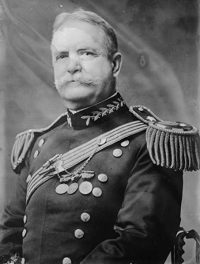Tagbilaran, Island of Bohol,
Philippine Islands, Sunday Morning,
March 25, 1900,
The Hospital.
I have been here, in the hospital I mean, sick with a fever six days now, and am beginning to feel really better this morning though weak. I seem to have had a pretty sharp attack of Dengue fever with a great deal of pain for two or three days and much weakness but thanks to skilful treatment and the great care of Dr. (Captain) C.L. Furbush, of the 44th Vol. Infantry, seem fairly in the road to recovery, which means a good deal to a man playing Robinson Crusoe — with some two hundred others — on this hitherto unknown island of the archipelago.
Still it is hard to imagine, as I write in the cool, well shaded room of the house we have taken as a hospital that the little command under Major Hale is as absolutely cut off from the world as is the case, without means of communication with the other islands, except by native’s boat, with no transport of its own, no cables, simply provisioned for two months and tossed on the shore of an unknown island, to meet and control conditions of which no knowledge could be previously obtained and with two companies of infantry to protect, control, [mould?], overawe if necessary, a population of something like two hundred and fifty thousand natives who for nearly two years have lived under their own independent government. However, as I say, it is a pretty house — this hospital — in all but its name; surrounded by bananas and topped by [feathery?] palms it is a true lodge in a wilderness from our point of view, whereas from another it occupies a corner of a street that for cleanness and straightness might belong to a New England village, and on this bright Sunday morning, as the people return in groups from church, has the moral air of that great land, an [inner?] breath of peace and good will to men stealing out as it were over a sunshine and heat such as New England never felt.
Indeed the groups returning from church are good to look upon, all dressed in their best, clean and sober minded, the men usually without hats and bare-footed, but wearing oftentimes a light coat, [otherwise?] the inevitable shirt and trousers, the women with bare feet as a rule, and perhaps [slippers?], with black shirts and over their heads a garment not unlike the head dress of the Breton peasants, with a stiff piece over the head like an Italian [illegible ] and a long white veil trimmed or embroidered at the edges, a picturesque garment, but goulish [sic ] as the shades of evening fall and a silent c[ ] comes moving down the street from vesper service.
The Bojolanos are a pleasant people, larger and of lighter color than the natives of other islands of the Visayas whom I have seen, and with more open and intelligent faces. They appear friendly and respectful but are very shy. The women are modest in appearance and prettier than others, they have finer complexions and their mouths and teeth do not seem as fouled by the use of beetle-nut; they are larger, too, with more curves to their figures and flesh on their bones than have the willowy, bamboo shaped houris of Panay. They seem very modest and unsophisticated too and Dr. Furbush is [authority?] for saying there is no venereal disease on the island — pretty well for nearly 250 thousand people. Certainly it is a primitive Robinson Crusoe kind of an island in Arcadia now that the Spaniard has gone. But alas the snake has entered Paradise, small pox is rampant, and dysentery and fevers plentiful enough. Doctors there seem to be none, but a medicine woman or man here do their practices on the miseries of the sick. One little child dying of dysentery the doctor found with a green leaf tied to its leg, and its chest sprinkled with tea leaves. But what can they do for things, it is the best they have. This child died in spite of all the doctor could do, and he worked hard over it, and the poor mother almost a child herself was frustrated with grief for her first-born. The father, however, seemed stolid and indifferent, but it seems was [reproved?] for his callousness by the sympathy of neighbors, hard as it seems that these people are not heartless to their own as there is reason to believe the case with many of the Malays. In fact their lighter color, larger frames and well nourished bodies, well developed and rounded limbs seem to indicate a better type than the skinny monkey like inhabitants of Panay, and the quantity of clothing worn especially by women, the more graceful flowing garments and set of the clothes seem to indicate a nearer affinity to European ideas amongst the Bojolanos than elsewhere in the Visayas.
